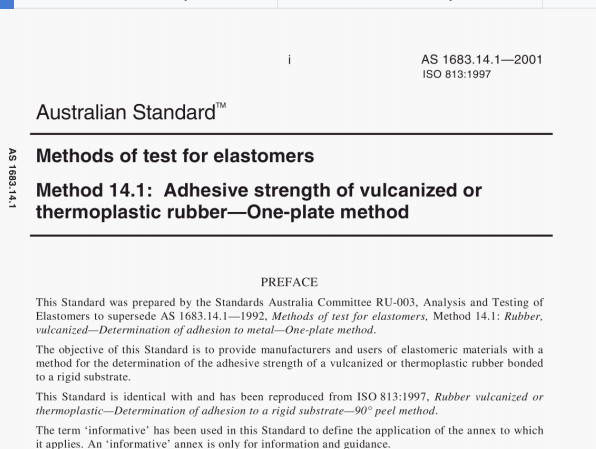AS 1683.14.1:2001 pdf – Methods of test for elastomers Method 14.1: Adhesive strength of vulcanized orthermoplastic rubber-One-plate method.
5.2.4 In the case of a rubber bonded with a heat-curing adhesive, carry out the vulcanization and/or bonding by heating the mould under pressure in a suitable press for the time and at the temperature required by the system being investigated.
Take great care when removing the test pieces from the mould to avoid subjecting the bonded surfaces to undue stress before the test pieces have cooled,
NOTE — When the substrate used 5 a thermoplastic material, the strip may in some cases need to be raised to a temperature above its softening point In order to ensure adhesion. When the substrate is a thermosetting polymer, the starting material may in some cases be a low-viscosity prepolyrner at the test piece Preparation temperature, whose polymerization is completed during the process. The mould and the moukling pressure will have to be adapted to such cases
5.2.5 When more than one test piece is prepared at a time, separate the test pieces from each other for testing. Do this by cutting with scissors, a knife or another suitable tool. The edges of each test piece may then be butted on a belt sander to bring the edge of the rubber flush with the edge of the substrate. Take care not to overheat the test piece and not to reduce the width of the test piece beyond the tolerance allowed.
5.3 Number
Four test pieces shall be tested.
5.4 Conditioning before testing
The time interval between the preparation of the test pieces and testing shall be in accordance with the requirements of ISO 471. It shall be at least 16 h after moulding.
Condition the test pieces in accordance with the requirements of ISO 471 for at least 16 h at a standard temperature (23 C ±2 C or 27 C ±2 C) immediately before the test.
When a test at other than standard temperature is required, carry out additional conditioning at this temperature for long enough to bring the material to the required temperature. ISO 3383 gives guidances on the conditioning time necessary to reach temperature equdibrium.
6 Test temperature and humidity
Unless otherwise specified, carry out testing at standard laboratory temperature and humidity, as specified in
ISO 471.
When other test temperatures are required, take them as far as possible, from the list of preferred temperatures given in ISO 471.
Use the same temperature throughout any one test, as welt as any series of tests intended to be comparable.
7 Procedure
7.1 Place the test piece symmetrically in the fixture (4.2), with the end to be pulled apart facing towards the operator. Before applying the load, strip the rubber from the substrate for a distance of approximately 1.5 mm using a sharp knife. Place the free end of the rubber strip in the grip (4.3). In the case of tests at other than standard temperature, keep the test piece in the temperature-controlled chamber (4.4) for a sufficient length of time after closure of the chamber for the test piece to reach the required temperature. Then move the grip of the tensile-testing machine at 50 mrrVmin ±5 mriVmin until separation is complete. Record the maximum force required to cause separation.
NOTE — Other speeds of separation may be used to examine the viscoelastic behaviour of the bond (see annex A). In such cases, the use of logarithmic Increments in the speed of separation is recommended.
7.2 An autographic recording of the force of adhesion over the full length of the test piece may also be made.
AS 1683.14.1:2001 pdf – Methods of test for elastomers Method 14.1: Adhesive strength of vulcanized orthermoplastic rubber-One-plate method
